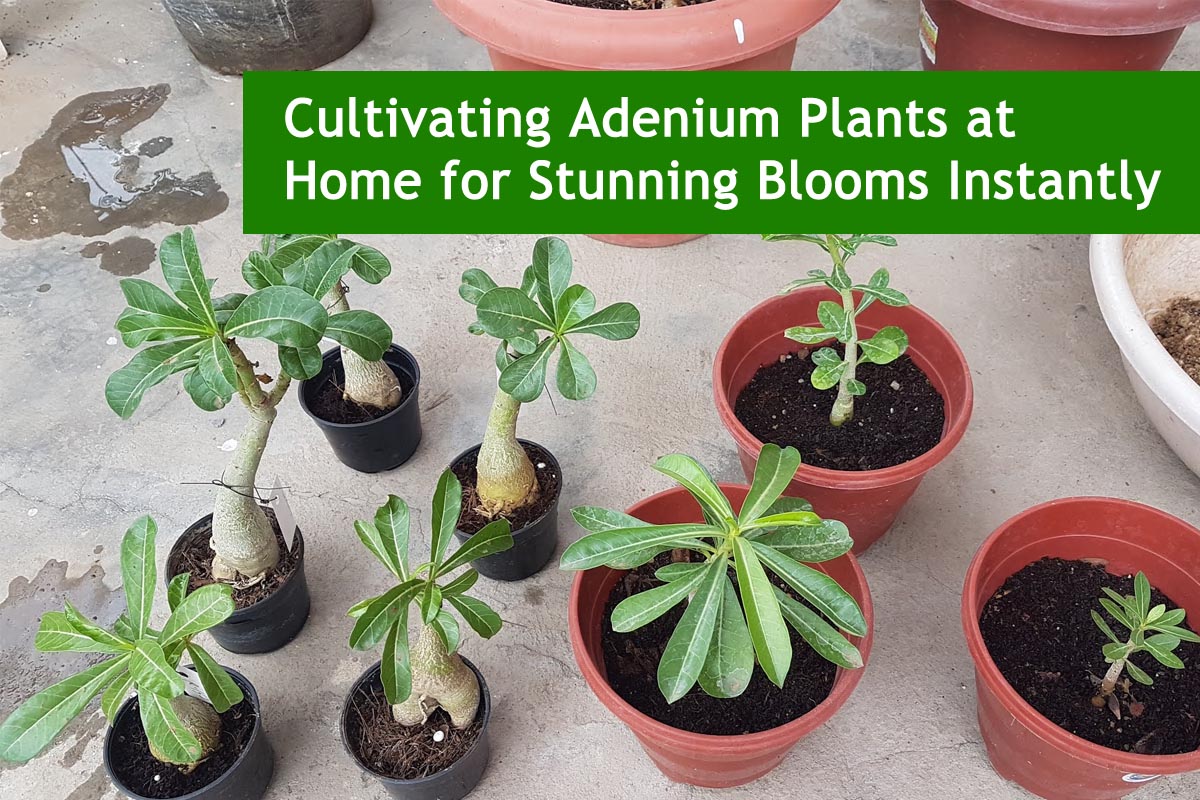
Cultivating Adenium Plants at Home for Stunning Blooms Instantly
Adenium plants, also known as desert roses or mock azaleas, are beloved for their striking appearance and vibrant blooms. Originating from arid regions of Africa and Arabia, these succulent plants have gained popularity worldwide for their ability to thrive in dry, hot conditions and their stunning flowers. Cultivating Adenium plants at home can be a rewarding experience, especially when you’re able to achieve beautiful blooms quickly. In this guide, we’ll explore the essential steps and tips to grow Adenium plants successfully and encourage immediate flowering.
Choosing the Right Adenium Variety:
Adenium plants come in various species and cultivars, each with its own unique characteristics and growth habits. When selecting a plant for your home, consider factors such as size, flower color, and growth pattern. Popular varieties include Adenium obesum, Adenium arabicum, and Adenium somalense. Choose a variety that suits your preferences and the available space in your home or garden.

Also Read This : Buzz Off! Insects Stuck in Hibiscus Buds? Try These Hacks to Send Them Packing
Selecting the Ideal Location:
Adenium plants thrive in full sunlight, so choose a sunny spot for optimal growth. A south-facing window or a location with at least six hours of direct sunlight is ideal. Ensure that the area has good air circulation to prevent fungal diseases and encourage healthy growth. If you’re growing Adenium plants outdoors, place them in a sunny, sheltered spot, protected from strong winds.
Providing Well-Draining Soil:
Adenium plants prefer well-draining soil to prevent waterlogging, which can lead to root rot. Use a cactus or succulent potting mix or create your own by mixing equal parts of coarse sand, perlite, and potting soil. Add a layer of gravel or small rocks at the bottom of the pot to further improve drainage.
Also Read This : Mastering Potting Soil: The Ultimate Guide to Knowing When and How to Change It
Choosing the Right Container:
Select a pot or container that allows for adequate drainage and provides enough space for the plant’s roots to grow. Terra cotta pots are excellent choices as they allow excess moisture to evaporate quickly. Ensure that the container has drainage holes at the bottom to prevent water from pooling around the roots.
Watering Adequately:
Adenium plants are drought-tolerant once established, but they still require regular watering, especially during the growing season. Water the plant thoroughly when the top inch of soil feels dry to the touch, then allow the soil to dry out before watering again. Avoid overwatering, as this can cause root rot and other problems. During the dormant season, reduce watering to prevent the plant from sitting in soggy soil.
Also Read This : 4 DIY Organic Fertilizers: Easy Recipes for a Thriving Garden
Fertilizing Appropriately:
Feed your Adenium plant with a balanced fertilizer formulated for flowering plants during the growing season. Dilute the fertilizer to half the recommended strength and apply it every two to four weeks. Avoid fertilizing during the dormant season, as the plant is not actively growing and does not require additional nutrients.
Pruning and Shaping:
Pruning is essential for maintaining the shape and health of your Adenium plant. Remove any dead, diseased, or overgrown branches to encourage new growth and improve air circulation. You can also prune the plant to create a more compact and bushy appearance. Use sharp, clean pruning shears and make clean cuts to prevent damage to the plant.
Also Read This : Enhance Your Curb Appeal: Front Door Plants for a Showstopping Entrance
Encouraging Immediate Flowering:
While Adenium plants typically take a few years to mature and bloom, there are ways to encourage immediate flowering. One method is to stress the plant by withholding water for a short period, typically a week or two. This mimics the harsh conditions of their natural habitat and can trigger the plant to produce flowers as a survival mechanism. However, be cautious not to stress the plant excessively, as it can lead to long-term damage.
Protecting from Pests and Diseases:
Keep an eye out for common pests such as aphids, spider mites, and mealybugs, which can infest Adenium plants and cause damage. Regularly inspect the plant for signs of infestation, such as yellowing leaves, distorted growth, or sticky residue. Treat any infestations promptly with insecticidal soap or neem oil, taking care to follow the instructions on the product label. Additionally, avoid overwatering and provide proper air circulation to prevent fungal diseases such as powdery mildew and root rot.
Also Read This : 10 Summer Houseplants That Thrive on Neglect: Minimal Maintenance, Maximum Greenery!
Enjoying the Blooms:
With proper care and attention, your Adenium plant will reward you with stunning blooms that brighten up your home or garden. Take time to admire the intricate patterns and vibrant colors of the flowers, which can range from shades of pink, red, white, and purple. Regularly deadhead spent flowers to promote continuous blooming and maintain the plant’s appearance.
Also Read This : 4 Easy Tips to Shield Your Tulsi Plant from Harsh Sunlight
In conclusion, cultivating Adenium plants at home for stunning blooms can be a fulfilling and enjoyable endeavor. By following the tips outlined in this guide, you can create an optimal growing environment for your Adenium plant and encourage immediate flowering. With patience, care, and a little bit of luck, you’ll be able to enjoy the beauty of Adenium blooms in your home or garden for years to come.




